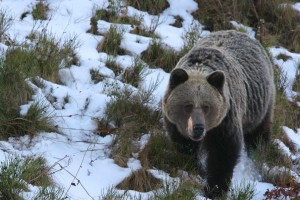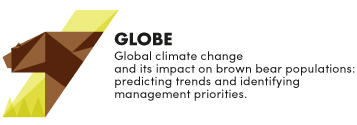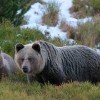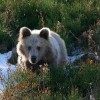 Warming climate drove the decline of brown bear twofold, indirectly by promoting human expansion, but also directly, possibly by disturbing bears' hibernation period, new study published by the GLOBE team in the Scientific Reports shows.
Warming climate drove the decline of brown bear twofold, indirectly by promoting human expansion, but also directly, possibly by disturbing bears' hibernation period, new study published by the GLOBE team in the Scientific Reports shows.
12,000 years ago brown bears used to roam over the entire European continent, but gradually their species' range collapsed to today's patchy populations. This decline coincided with rapid expansion of humans, but also with climate warming. Brown bears live in a wide range of climates, from dry deserts to cold Arctic tundra. Why would increase in temperature exert an adverse effect on them? It is the bears' winter hibernation, when female brown bears give birth, that turns out to be the most vulnerable period. Counter-intuitively, bear females need more energy during hibernation when it is warmer, which means they need to feed longer to build up more fat. By comparing data on female reproduction from bear populations around the world, the researchers found that indeed bears reproduce at lower rate at higher temperatures.
Previous research suggests that climate warming and humans might have had synergistic effects on the extinction of large mammals. In this study, the team of researchers managed to tease apart the role of climate warming from that of human expansion in the decline of bears in Europe. "We used information from more than 3,400 archaeological sites to extract data on the brown bear presence" says Jörg Albrecht, leader of the study. "On this basis, we could start reconstructing the changes of the bear population range over the last 12,000 years". Clearly, such data was incomplete and contained large gaps. "To fill these gaps, we have built a spatial metapopulation model, simulating local extinctions and colonisations by bears, and used a technique called Bayesian estimation" adds Kamil Bartoń, from the Institute of Nature Conservation, Polish Academy of Sciences. These methods are computationally very intensive, but with powerful supercomputers over the PLGrid system the calculations that would have otherwise taken more than one year could be completed in a few days. The results of the study suggest that increasing winter temperatures have much contributed to the bear decline. "However, we also show that humans have strongly fostered this process, because persecution of bears was already widespread across human cultures in the Northern Hemisphere several thousand years ago”, adds Richard Bischof, from the Norwegian University of Life Sciences.
The study was conducted by an international team of scientists from the Institute of Nature Conservation, Polish Academy of Sciences in Kraków, the Norwegian University of Life Sciences, and University of Rostock in Germany.
More information in the article: www.nature.com/articles/s41598-017-10772-6
photo by Adam Wajrak ©





















